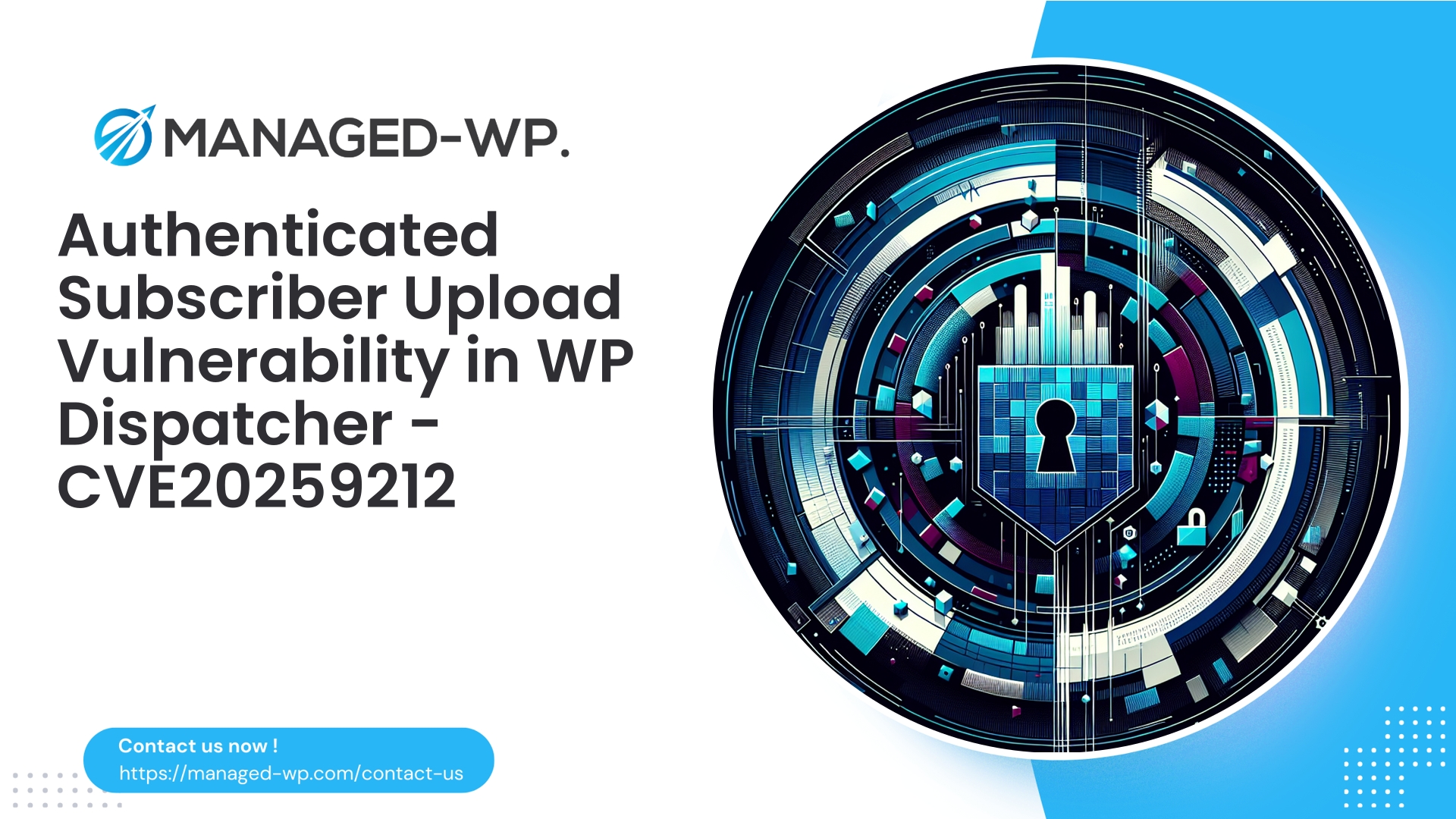| 插件名稱 | WP Dispatcher |
|---|---|
| 漏洞類型 | 已認證的 SQL 注入 |
| CVE編號 | CVE-2025-10582 |
| 緊急 | 低的 |
| CVE 發布日期 | 2025-10-03 |
| 來源網址 | CVE-2025-10582 |
WP Dispatcher (<= 1.2.0) — 認證貢獻者 SQL 注入漏洞 (CVE-2025-10582):WordPress 網站所有者必備指南
安全研究人員近日揭露了 WP Dispatcher 外掛程式中的 SQL 注入漏洞,影響 1.2.0 及更早版本,漏洞編號為 CVE-2025-10582。此漏洞允許具有「貢獻者」等級權限的已認證使用者透過外掛程式暴露的輸入註入惡意 SQL 語句。由於「貢獻者」帳戶通常分配給外部內容提供者(例如客座作者和實習生),尤其是在多作者 WordPress 網站上,因此這種攻擊途徑尤其令人擔憂。
在本簡報中,Managed-WP 的安全專家將深入剖析此漏洞的性質、可能的利用途徑、檢測策略,以及——最為關鍵的是——切實可行的、優先排序的 WordPress 環境防禦行動計劃。此外,我們還將概述 Managed-WP 的虛擬補丁如何在官方插件更新發布之前提供即時保護層。
作為一支總部位於美國的安全營運團隊,我們專注於託管 WordPress 防火牆和事件回應,本指南反映了我們在實際操作經驗和保護客戶網站在即時環境中的最佳實踐。
TL;DR(摘要)
- 漏洞:WP Dispatcher 外掛程式(版本 ≤ 1.2.0)中的驗證 SQL 注入。
- 所需存取權限:貢獻者等級或更高等級的身份驗證。
- 潛在影響:資料庫遭到入侵、資料外洩、帳戶被列舉、網站完全被接管。
- 官方補丁狀態:截至披露時,尚無可用補丁。
- 建議立即採取的措施:停用或刪除外掛程式、封鎖外掛程式端點、限制貢獻者權限、進行使用者審核、啟用 Managed-WP 虛擬修補、掃描入侵指標、輪替憑證並驗證備份。
- 長期策略:強制執行最小權限原則,維護外掛程式安全,實施持續監控,並持續更新 WAF 規則。
為什麼這種漏洞需要您關注
SQL注入仍然是最嚴重的Web安全漏洞之一,因為它直接威脅網站核心資料的完整性和機密性。即使是權限較低的用戶,例如貢獻者,也可以利用此類漏洞大幅擴大其影響範圍。
本案例中存在的特殊風險包括:
- 貢獻者角色的共同點: 編輯型和多作者網站通常會隨意分配投稿人權限,從而增加攻擊面。
- 身份驗證要求: 攻擊者不需要管理員或編輯帳戶——獲取或建立貢獻者帳戶就足夠了。
- 資料外洩風險: SQL注入攻擊可以竊取敏感使用者憑證並修改資料庫內容。
- 缺少補丁: 在官方修復方案出台之前,採取積極主動的緩解措施對於防止漏洞至關重要。
利用機制(攻擊者可能如何利用此漏洞)
雖然我們不會公佈漏洞利用程式碼,但此類經過驗證的 SQL 注入漏洞中常見的攻擊流程如下:
- 攻擊者透過被盜用的憑證、弱密碼策略或自助註冊流程等方式,獲得了經過驗證的貢獻者存取權限。
- 受害插件暴露了一個 API 端點或頁面,使用者提供的輸入會與資料庫查詢進行不安全的交互,缺乏適當的清理或參數化。
- 攻擊者精心建構包含注入語法的 SQL 有效載荷(
' 或 1=1 --,聯合選擇或諸如此類的定時攻擊睡眠(5)) 來操作查詢邏輯。 - 資料庫執行這些惡意查詢,導致使用者資料外洩或允許未經授權的寫入操作。
- 攻擊者利用提取的資料進行進一步入侵或植入持久性後門。
要點: 外掛程式無需 WordPress 即可將原始輸入連接到 SQL 查詢中 $wpdb->prepare() 非常脆弱。
潛在後果(從最壞到常見)
- 敏感資訊洩露,包括用戶電子郵件和密碼雜湊。
- 透過憑證竊取和橫向轉移進行帳戶接管。
- 植入惡意內容或管理後門。
- 透過隱藏的計畫任務或修改後的選項實現不被察覺的持久化。
- 資料外洩導致聲譽受損和違反合規規定。
即使是有限的資料外洩也有可能升級為整個網站被攻破。
立即優先採取的行動(依推薦順序)
- 確定受影響的安裝: 使用 WP-CLI 或主機控制面板審核所有 WordPress 實例中是否存在 WP Dispatcher 外掛程式以及外掛程式版本。
- 例子:
wp plugin list --status=active然後使用 grep 命令搜尋“wp-dispatcher”。
- 例子:
- 停用或移除存在漏洞的版本: 如果無法更新,請立即停用插件。
- 停用命令:
wp 外掛程式停用 wp-dispatcher - 如果移除不是可行的方案,則限制存取並透過 Managed-WP 的防火牆套用虛擬修補程式。
- 停用命令:
- 限制貢獻者角色權限: 暫時移除類似權限
編輯貼文並限制對插件端點的存取。 - 強制重設所有貢獻者及以上等級帳戶的密碼: 強制使用更強的密碼,並使用管理工具進行批次重設。
- 審核所有用戶: 檢查最近的登入記錄並停用可疑帳戶。
- 審核日誌: 尋找異常請求和可能的注入嘗試。
- 進行惡意軟體和後門掃描: 檢查資料庫、檔案和定時任務是否有異常。
- 事件響應: 如果偵測到入侵,則隔離站點,進行取證快照,從乾淨的備份中恢復,輪換密鑰,並執行徹底的審計。
- 通訊: 根據需要通知相關利益方並遵守資料外洩法規。
安全監控:偵測技術
請注意日誌和請求中是否有以下可疑跡象:
- 對插件特定端點(例如,管理員 AJAX 操作)進行身份驗證的 POST/GET 呼叫。
- 包含常見 SQL 注入關鍵字的參數:
聯盟,選擇,睡覺,或 1=1SQL 註釋--,/*. - 異常的時間延遲表示存在盲注嘗試。
- 來自相同 IP 位址或帳戶的重複可疑負載變體。
- 解碼為 SQL 令牌的編碼有效載荷(URL 或 base64)。
- 日誌中發現了意外的資料庫錯誤。
- 意外變更:新增管理員使用者、選項變更或匯入內容異常。
需要發出警報的日誌模式範例:
admin-ajax.php?action=wp_dispatcher_*使用 SQL 關鍵字聯合選擇,OR+1=1, 或者睡覺(.
如果採用集中式日誌平台(ELK、CloudWatch),請針對這些特定模式設定警報。
優先處理您的回复
- 優先級 1: 擁有眾多貢獻者、開放註冊或敏感資料的網站(會員網站、電子商務)。
- 優先級 2: 運行存在漏洞的插件且貢獻者使用量極少的網站。
- 優先級 3: 沒有安裝插件的網站——保持最佳實踐,但降低緊迫性。
對於管理多個站點,可利用腳本自動化或 Managed-WP 的 WAF 管理進行快速審核和緩解。
事件控制檢查清單
- 在 Web 伺服器或 WAF 層阻止外掛程式端點進行未經授權的存取。
- 停用所有受影響網站上有漏洞的 WP Dispatcher 外掛程式。
- 重設 Contributor+ 密碼,強制重新驗證身分。
- 審計資料庫表(
wp_users,wp_options,wp_posts(以及自訂插件表)以防止未經授權的變更。 - 在進行進一步變更之前,請對文件和資料庫進行取證備份。
- 如果確認系統遭到入侵,則從經過驗證的乾淨備份中恢復,並在恢復後加強系統安全。
- 恢復主動監控和增強型WAF保護,以偵測重複攻擊。
長期緩解和加固
- 強制執行最小權限原則:定期審核和調整貢獻者權限。
- 加強作者註冊:人工審批、電子郵件驗證和速率限制。
- 嚴格管理插件:只安裝來自信譽良好的來源並經過程式碼審查的插件。
- 要求所有具有發佈權限的使用者啟用多因素身份驗證 (MFA)。
- 實施定期備份並驗證復原流程。
- 部署主機和應用程式日誌監控,以發現異常情況。
- 使用 Managed-WP 等託管虛擬修補程式服務,可以快速抵禦已知漏洞。
託管式 WP 虛擬修補程式:即時保護
虛擬修補是指部署有針對性的WAF規則,在攻擊嘗試到達易受攻擊的插件程式碼之前,就在網路邊緣阻止這些規則。這種方法可以有效降低風險,直到插件供應商發布官方修復。
我們配置了具有多層防禦的虛擬補丁:
- 阻止傳送到外掛端點(例如 AJAX 操作)的惡意負載。
- 增強對來自低權限角色(例如“貢獻者”)的已認證請求的過濾。
- 限制對低吞吐量端點的請求速率。
- 結合 SQL 注入簽章和異常請求行為的啟發式偵測。
- 在可行的情況下,將預期的輸入參數列入允許清單。
ModSecurity 規則範例片段:
SecRule REQUEST_URI "@contains /wp-admin/admin-ajax.php" "phase:2,chain,deny,status:403,log,msg:'Managed-WP WAF: SQLi block for WP Dispatcher'" SecRule ARGS_NNSTERSDREi (union(\s+all)?\s+select|sleep\(|benchmark\(|or\s+\d+=\d+|--|/\*|\bconcat\(|information_schema|load_file\()" "t:none,t:lowercase,chain" SecRule REQUEST4U4U4ST
簡化的應用程式邏輯(偽代碼):
如果請求已認證且使用者角色在['contributor', 'author']中,並且請求路徑匹配'wp-dispatcher',則如果請求參數中包含 SQL 注入模式,則拒絕請求並傳回錯誤代碼 403,提示「潛在的 SQL 注入攻擊已被阻止」。
- 規則會記錄並阻止可疑活動。
- 對於高置信度匹配,採用“阻止並通知”模式;對於低置信度匹配,採用“僅提醒”模式。
- 利用 IP 信譽服務來限製或封鎖重犯者。
可與IDS/WAF整合的偵測特徵
- 聯合式註射:
(?i)union(?:\s+all)?\s+select - 基於時間的盲注:
(?i)(睡眠|基準測試)\s*\( - 布爾有效載荷:
(?i)或\s+\d+\s*=\s*\d+ - SQL 註解分隔符號:
--|/\* - 元資料/模式探測:
(?i)資訊模式|pg_catalog|sqlite_master|資料庫\(\) - 編碼有效載荷: 百分比編碼變體
%75%6e%69%6f%6e(聯盟)
選擇性地將這些應用於插件特定的端點和已認證的貢獻者會話。
事件後取證審查清單
- 修復前請保留所有相關日誌和備份。
- 分析資料庫查詢日誌和慢查詢日誌,尋找異常狀況。
- 尋找未經授權的管理員使用者或可疑的選項條目。
- 掃描
wp_posts以及用於注入後門的媒體表。 - 檢查定時任務是否有未經授權的排程任務。
- 檢查 PHP 和 Web 伺服器錯誤日誌,尋找 SQL 語法錯誤,這些錯誤可能表示存在註入嘗試。
- 查看
可濕性粉劑內容用於上傳文件、主題或外掛程式中意外出現的 PHP 檔案。
面向插件開發者的安全編碼建議
如果你開發 WordPress 插件,那麼保護資料庫查詢安全至關重要:
- 使用
$wpdb->prepare()所有涉及使用者輸入的 SQL 查詢。 - 切勿將未經信任的輸入直接連接到 SQL 命令中。
- 根據枚舉值的允許清單驗證輸入。
- 對所有狀態改變操作實施能力檢查和隨機數驗證。
- 使用諸如以下的函數對輸出進行適當的清理:
esc_html()和esc_attr(). - 加入針對注入向量的模糊測試和單元測試。
實用檢測和管理命令
- 使用 WP-CLI 列出外掛程式及其版本:
wp plugin list --format=table
- 在伺服器上找到插件檔案:
ls -la wp-content/plugins | grep dispatcher
- 列表貢獻者使用者:
wp user list --role=contributor --fields=ID,user_login,user_email,roles,last_login
如果偵測到入侵—立即採取的後續步驟
- 透過維護模式和更嚴格的 WAF 策略隔離受影響的站點。
- 保存關鍵證據:日誌、資料庫轉儲和文件快照。
- 尋找疑似資料外洩事件發生前的完整備份,並制定復原計畫。
- 對於複雜的安全漏洞,應考慮聘請專業的事件回應團隊。
- 輪換所有相關憑證(資料庫使用者、FTP/SFTP、主機面板、API金鑰)。
- 在加強安全監控下重新啟用站點服務。
溝通、合規和資訊揭露最佳實踐
- 記錄所有事件的時間軸和補救措施。
- 如果懷疑個人資料洩露,請遵守所在司法管轄區的資料外洩通知法律。
- 以透明的方式向受影響用戶通報情況,以維護信任。
為什麼虛擬補丁是您目前最佳的防禦措施
當插件供應商尚未發布修復程式時,網站所有者面臨以下選擇:繼續運行存在漏洞的插件,承擔高風險;卸載插件以移除部分功能;或透過技術手段降低風險。虛擬修補程式是最佳折衷方案-既能維持網站功能,又能屏蔽已知漏洞。
Managed-WP 的虛擬補丁服務:
- 持續監控公開揭露的漏洞訊息,以便迅速更新防火牆規則。
- 立即部署 WAF 規則,阻止針對易受攻擊的插件端點的攻擊負載。
- 將基於特徵的檢測與行為分析相結合,以最大限度地減少誤報。
- 提供事件警報和報告功能,以實現事件可見性和主動防禦。
範例回應時間表:管理型工作計畫 24-72 小時行動指南
0-2小時:
- 確定受影響的實例,並在可行的情況下停用 WP Dispatcher。
- 立即套用 Managed-WP WAF 規則阻止外掛端點。
第 2 至 8 小時:
- 強制重置貢獻者及以上角色使用者的密碼。
- 啟動惡意軟體/後門掃描程式。
- 通知事件回應小組並準備溝通資料。
第一天:
- 進行全面的日誌審查和資料庫審計。
- 透過嚴格的WAF規則和監控,維持高度安全態勢。
第2-3天:
- 如果偵測到系統入侵,請從已驗證的乾淨備份中還原。
- 只有在官方修復或虛擬補丁發布後,才能重新啟用插件。
第一周:
- 審查並改善使用者入職流程、角色分配和權限範圍。
- 實施多因素身份驗證並強化密碼策略。
常見問題解答
Q:如果不使用 WP Dispatcher,我的安全嗎?
答:是的,此漏洞僅影響執行存在漏洞版本的插件的網站。不過,定期修補插件漏洞和部署Web應用防火牆(WAF)仍然是通用防護的最佳實務。
Q:虛擬補丁能否取代官方插件更新?
答:不。虛擬補丁是一種臨時但有效的風險降低策略。一旦廠商發布了補丁,您應該立即更新。
Q:未經身份驗證的用戶能否利用此漏洞?
答:不,攻擊者至少需要貢獻者等級的存取權限。但是,開放註冊或自動分配貢獻者角色的網站可能存在風險;限制這些設定可以降低風險。
緩解措施摘要清單
- 審核所有網站是否存在 WP Dispatcher 外掛程式以及外掛程式版本。
- 停用或卸載存在漏洞的插件版本。
- 如果外掛程式必須保持活動狀態,請使用 Managed-WP WAF 阻止外掛端點。
- 強制 Contributor+ 使用者重設密碼並審核帳戶清單。
- 掃描檔案和資料庫,尋找入侵跡象。
- 如果懷疑遭受攻擊,請保留日誌和備份。
- 強制執行安全加固措施,包括多因素身份驗證和最小權限原則。
- 官方補丁發布後,請立即更新插件。
立即保護您的 WordPress 網站 — 免費試用 Managed-WP
使用 Managed-WP 的免費套餐,立即獲得託管保護
為了快速有效地防禦此類漏洞,請註冊 Managed-WP 的基礎(免費)套餐。此套餐包含託管防火牆防護、應用程式級 WAF、惡意軟體掃描以及針對常見 Web 攻擊手段(例如 SQL 注入)的自動緩解措施。立即在此註冊,幾分鐘內即可保護您的 WordPress 網站: https://my.managed-wp.com/signup/free
對於多站點操作或高級虛擬修補程式和報告,我們的付費計劃提供進一步的自動化安全控制、威脅情報和優先支援。
結語-保持強大的安全態勢
外掛漏洞將持續為 WordPress 網站管理員帶來挑戰。關鍵在於採取審慎、迅速且由專家主導的應對措施,包括漏洞遏制、檢測、虛擬修補和持續加固。
如果您管理多個客戶站點,建立多站點清單,自動識別漏洞,並使用 Managed-WP 等託管虛擬修補程式服務來縮短出現新漏洞時的「保護時間」。
如需針對您的 WordPress 生態系統進行審計和保護方面的客製化協助,Managed-WP 的美國安全團隊隨時準備為您提供支援。
保持警惕,並立即檢查您的插件清單。



















